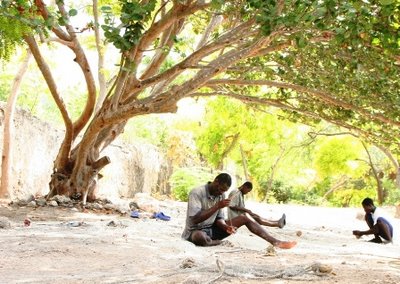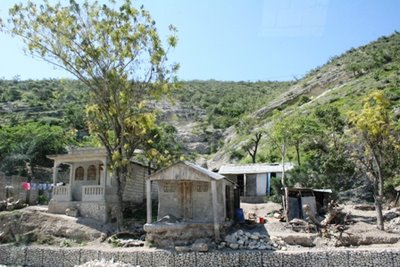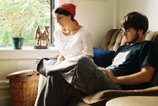HAITI
Things I think I saw. #2
Day 3, Sept. 9, 2006. This morning I woke to sounds of goats. Goats and donkeys, roosters and women.
A small Amish missionary girl climbs a small tree.

A fisherman with string between his toes repairs his nets. He works much faster than his two brothers. He says he can make 2,000 gourdes per day during the four good fishing months of the year. Some fish are as long as his arm, some only up to his elbow, the ones the size of his hand he throws back into the blue-blue water with a disdainful flip of his fish-measuring hand. Fishing runs in his family, he says, but his father was a bad manager – he spent the good fishing months money on women and beer. Our fisherman is different, he says, with a flash of a full-set of off-white teeth, he never asks for money: he flashes us a couple thousand gourdes. We wish each other bonswa and we are off in our country-improving foreign kind of way.
We ate fish in a restaurant in a red village, surrounded by red dirt, covered by red rocks and red children. The fish had been rubbed with lime and been given the right amount of spices. It was delicious. We ate it while a French trained woman sang the same song over and over in slow jazz style, her Creole tremulous, over the cardboard radio speaker behind my left ear. It was perfect.
Sunday. Day 4. Haitians sing like a fully-blown pipe organ. They hit the first chord hard and fast. Their song rises in a crescendo that never reaches its culmination. Their right side is filled with God according to the Creole Psalmist – this is the part that is always on the rise. Their Spirit loud and fast – fast not in terms of speed, fast as in secure. It is secure in its uplift, its lightness. It is not ephemeral in as much as it is clairvoyant. It is at once present and eternal. It is upward. Tight-limbed and smooth-skinned women, gently rocking, fill in the high parts at the proper place. Mothers hiss their white-eyed children into obeisance to its Spirit, men form the resonate laconic foundation of this God-worship. "Thank you for the chanti belle" the man prayed in the mint green and white shelter from the bleaching of the ultra-violent glare of the Caribbean sun.
 HAITI
HAITI
Things I think I saw. # 1Day 1. On the plane. Small girl, braids, glasses, dipping her tongue like a small black bird in a container of processed cheese.
Port-au-Prince a desiccated silvering city of low-flung, hill-clinging houses the color of dust.
Small boys and small men twisting under rivulets made by the sound of water on tin. They dance the rain dance, the dance of I’m free to have a shower and not have an umbrella. He is free to enjoy what is given.
Small boy, red shirt, leopard print purse draped squarely around his neck, stares blankly.
Hills the texture of New Zealand rise above the shimmering water. Pale green hills, a dusty path zigzagging up one’s side. Tired barren hills, they exist prior to us – since the beginning of matter, before the invention of slaves. Before we cared.
Day 2. Today I woke up with the third rooster – like Peter.
A man in a fisherman’s hat, machete in hand, barefoot, walks up a convoluted hard-packed stream of mud. His face laconic, impassive. His lack of expression speaks the sort of prose only someone like Borges could write.
We caused quite a stir by standing in the Haitian-only line, “Look the whites are standing in our line.”
We stop at the Haitian McDonalds for mashed plantains and spicy coleslaw. Local beauty saunters up holding the hand of a man.
Small fishing villages, fish traps woven by hand, boats line the shore, women and children run with arms outstretched – they want more than fish and salt.
I watch uneasily as our travel companion a Haitian saleswoman buys cement in Gonaïves. I am the only white man on the street. I feel overfed and conspicuous, overall, uncomfortable. I don’t know if I should help hoist the 85 lb. bags that the man balances effortlessly on his head. I feel like I will do the wrong thing no matter what. I stand unsure, uncertain, embarrassed. Bonswa. I say. Bonswa.
HAITIThe ProblemAccording to Ben Fountain, at an intersection in Accra, Ghana, a one-legged boy on crutches hobbles up to a car stuck in traffic. Inside are a driver, a diplomat's wife and a foreign visitor. As the boy extends his palm, the visitor pulls a clump of bank notes from her purse. "Don't give him money!" the diplomat's wife calls sharply. "That makes you part of the problem!" The visitor gives the beggar the money anyway. "As long as there's no solution," she replies, " I might as well be part of the problem."
The visitor wasn't my sister-in-law Bethanie. I don't think she's ever been to Ghana - physically. She lives in Haiti among sons and grandsons of once-upon-a-time slaves. She lives in a valley in between mountains on a slope in between ravines with lizards and scorched white rocks where the tether of community is still easy to grip; she lives against the disorienting cities where streets become dunes of garbage - filling out the open spaces, eruptioning in filth so colorfully rich they acheive a sort of abstraction.
Things are concrete where Bethanie lives. The Americans live in a compound surrounded by a fence (as do most missionaries who try to fix the problems of really poor people). The gates are locked at night. During the day the Haitians enter the compound and stand on porches, hang on yard fences and wait until the Mennonites have time to answer their questions and honor their requests. Its not easy living 7 hours from the nearest tomatoes; the running water is never heated; potatoes are a scarce commodity. But natives wash most of their clothes with (discontinued) wringing washers. Haitian cooks make Haitian food for the blancs and their native staff. Labor is in abundance but the Holmes County transplants can only hire so many people; only so many are allowed open access to the mission center's well of water (it's a long way to tote drinking water from the nearest mountain spring). The Mennonites only hire morally upstanding citizens which means most of them attend the church they built out of concrete and tin and painted white and mint green.
Bethanie is in charge of the clinic which forms the inadvertant center of town; outside its fence is the local market. Bethanie is the dispenser of medicine, of food for malnourished children, of HIV tests, of advice for young mothers, of tears. I'm sure she feels at times she might be contributing to the problem to which there is a solution which no one knows. She knows LaSource has a dual economy, a class system, a racial divide. She senses the cultural chauvenism and feels the desperate needs. She knows she is extending the dependency. She knows she isn't living like they do. It bothers her. It bothers her that the other whites talk about themselves, about each other (not always in front of each other's backs) about the place they are from rather than about potential solutions to the problem or what they must learn about their own problems.
One of Bethanie's favorite things to do is to sing - to sing like the Haitians - in a full-bore, gently-swaying, arm-waving sonorous uprush of sound and wind. Maybe it allows her to forget for just an instant her irreducible difference and remember the overwhelming familiarity she has with those she regards as human before they become others: objects to be fixed. Maybe for a second she feels completely a part of a community, a part of a whole. I suspect that in this moment the spiritual aspect of being-in-relation fills her soul and she (sub) consciously feels as though she might be part of a solution.
We miss not living near Bethanie, yet we know that for now she is where she wants to be - where she can help mothers to live to see another day, children to distend their bellies no longer, HIV patients to contribute socially and give orphans her shoes so they can go to school. If Bethanie is adding to the problems of the world, I'm glad she can do it in a place where she can at least sing like a Haitian. It's nice to have a problem for a sister-in-law.
 NEW HUMANEve BarnhartIt seems extraordinary that just last week little Eve was inside Marilyn. Just as God breathed into Eve the breath of Life and she became a living soul, so Marilyn was breathing into the soul of little Eve. Guess she is in God’s hands now. Or maybe in Harlan’s. He says that in two years she’ll prefer him.
NEW HUMANEve BarnhartIt seems extraordinary that just last week little Eve was inside Marilyn. Just as God breathed into Eve the breath of Life and she became a living soul, so Marilyn was breathing into the soul of little Eve. Guess she is in God’s hands now. Or maybe in Harlan’s. He says that in two years she’ll prefer him.
If you want to see more photos of our beautifully and wonderfully made fellow human you can follow this link: www.ebarnhart.photosite.com
 SEEINGLooking at Pollock
SEEINGLooking at Pollock
The first time I looked at Pollock’s Autumn Rhythm No. 30 with eyes wide open I was terrified by its intensity. Lines undulating ever nearer, closer. Violence, both overt and covert. Rhythm over rhythm. Line over line. System over system. It’s an impressive image. It makes it easy to forget the assumptions. It’s addictive, the power it seems to diagram. Looking with eyes wide open is not a glance; it’s staring until you cry.
I remember when those books with three dimensional shapes hidden within nonsensical pages of colors and shapes (if you looked at it cross-eyed at the tip of your nose and backed off slowly – “look through the page”) were a big hit with my Dad. I could never get them to work. Pollock is not so overt. He, the Wyoming wild-man, pictures Life near and far, abstract and concrete in tactile slashes of intersecting streams of color and non-color. Look across time from outer-space; see us swim under a micro-scope. There is nothing to see except for what is.
Pollock’s work is direct, immediately present. There is no drawing; there are no edges. It is raw and real. A huge walked-over canvas loses me in a world of seeing. Pollock is easy to replicate at one or two strokes of brush-flung paint. What designates his work as inimitable is not his individual marks, it’s the way he combined, layered and mixed color and intensity. Pollock paints a picture of “everything which is natural, which is infinite, which is yes.” He gives us a window. All we need to do is look.Inspired by a trip to the Guggenheim Museum of Art, and E.E. Cummings. See the exhibition No Limits, Just Edges: Jackson Pollock Paintings on Paper at this web address: http://www.guggenheim.org/pollock/index.html







